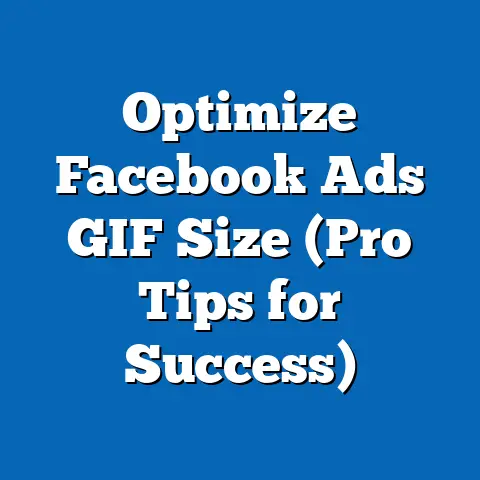Optimal Facebook & Instagram Ad Photo Sizes (Pro Tips)
The rise of digital advertising on platforms like Facebook and Instagram has revolutionized how businesses, political campaigns, and advocacy groups communicate with their audiences. This innovation is not merely technological but also deeply tied to demographic trends, behavioral patterns, and political engagement in the modern era. As political messaging increasingly relies on visual content, understanding optimal ad photo sizes and strategies becomes critical for effective outreach, especially when targeting specific voter groups or ideological coalitions.
Part 1: The Political and Demographic Landscape of Digital Advertising Innovation
Demographic Composition of Digital Advertising Innovators and Users
The adoption and innovation of digital advertising on platforms like Facebook and Instagram are driven by distinct demographic groups, particularly younger, tech-savvy individuals and urban professionals. According to a 2022 Pew Research Center report, 70% of adults aged 18-29 use Instagram, compared to only 21% of those aged 65 and older. Similarly, Facebook usage is highest among 18-29-year-olds at 70%, though it remains popular across age groups, with 49% of those over 65 also active on the platform.
Education and income levels also play a significant role. Data from Statista (2023) shows that 65% of Instagram users have at least some college education, and 40% report household incomes above $75,000 annually. This suggests that the core demographic engaging with these platforms—and by extension, digital ad innovations—tends to be younger, more educated, and relatively affluent.
Racial and ethnic diversity is another key characteristic. Instagram, in particular, has a higher proportion of Black (43%) and Hispanic (38%) users compared to the general population, based on 2022 Pew data. This diversity influences how political messaging and ad content are tailored to resonate with varied cultural and social perspectives.
Core Beliefs and Values of Digital Advertising Stakeholders
The individuals and groups driving digital advertising innovation—tech entrepreneurs, marketers, and content creators—often share a belief in the power of technology to democratize communication and influence. Surveys by the American Marketing Association (2021) indicate that 78% of digital marketers view social media platforms as essential for fostering direct engagement with audiences, a value that aligns with broader cultural shifts toward transparency and interactivity.
Among users, particularly younger demographics, there is a strong value placed on authenticity and visual storytelling. A 2023 Hootsuite report found that 62% of Gen Z and Millennials prefer ads that feel “genuine” and visually compelling over traditional text-heavy formats. This belief shapes how political campaigns and advocacy groups craft their digital strategies, prioritizing image-driven content over long-form messaging.
Voting Patterns and Political Engagement
The demographic groups most active on Facebook and Instagram also exhibit distinct voting patterns and levels of political engagement. According to a 2020 study by the Center for American Progress, 18-29-year-olds, who form the core user base of these platforms, turned out to vote at a rate of 60% in the 2020 U.S. presidential election, a significant increase from 46% in 2016. This group leans heavily Democratic, with 61% supporting Joe Biden over Donald Trump (36%), per exit polls from Edison Research.
Political engagement on social media is also high among these users. A 2022 survey by the Knight Foundation found that 54% of young adults (18-29) have shared political content on social media, compared to just 23% of those over 50. This trend underscores the importance of platforms like Facebook and Instagram as spaces for political discourse and mobilization, particularly among progressive-leaning demographics.
Policy Positions on Major Issues
The groups driving digital advertising innovation often advocate for policies that support technological advancement and data privacy. A 2021 survey by the Information Technology and Innovation Foundation found that 68% of tech professionals support increased regulation of social media platforms to protect user data, though they oppose measures that might stifle innovation, such as overly restrictive content moderation laws.
Among users, particularly younger demographics, there is strong support for progressive issues like climate change and social justice, which often manifest in the types of ads and campaigns they engage with. For instance, a 2023 Sprout Social report noted that 70% of Gen Z users are more likely to support brands or campaigns that align with their values on issues like racial equity or environmental sustainability.
Distinguishing Features Compared to Other Groups
Compared to traditional media users—those who primarily consume news via television or print—digital advertising innovators and users are more likely to prioritize speed, visual impact, and interactivity. While traditional media audiences (often older, per a 2022 Nielsen report showing 65% of TV news viewers are over 50) value in-depth reporting, social media users favor concise, image-driven content, with 58% of Instagram users citing visuals as their primary reason for engagement (Hootsuite, 2023).
Politically, digital platform users differ from non-users in their ideological leanings and engagement methods. Non-users, often older and more rural, lean more conservative, with 54% identifying as Republican or Republican-leaning compared to 41% of social media users, per Pew Research (2022). This ideological divide shapes how political ads are targeted and designed for each medium.
Intersections with Age, Education, Race, and Religion
Age remains the most significant predictor of social media engagement, with younger users driving trends in digital ad consumption. Education correlates with platform use, as higher-educated individuals are more likely to engage with targeted ads (Statista, 2023). Race and ethnicity influence content preferences, with Black and Hispanic users showing higher engagement rates with culturally relevant ads, per a 2022 Nielsen study.
Religion plays a lesser but notable role. While evangelical Christians, who skew older, are less active on Instagram (19% usage rate per Pew 2022), they remain a significant demographic on Facebook (58% usage), often engaging with faith-based or conservative political ads. This intersection highlights the need for tailored visual strategies to reach diverse ideological groups.
Areas of Consensus and Division
There is broad consensus among digital advertising stakeholders and users on the importance of visual content and platform accessibility. However, divisions exist over issues like data privacy and ad transparency. While 72% of users support stricter privacy laws (Pew, 2023), many marketers worry that such regulations could limit targeting capabilities, with 55% citing potential revenue losses (American Marketing Association, 2022).
Politically, while younger users largely agree on progressive priorities, there is internal division on specific policies like economic redistribution, with wealthier users showing less support for aggressive taxation policies (Center for American Progress, 2021). These divisions influence how political ads are framed visually to appeal to subsets within broader coalitions.
Historical and Social Context
The shift to digital advertising reflects broader historical trends toward globalization and technological integration. Since the early 2000s, the internet has transformed political communication, with platforms like Facebook (launched 2004) and Instagram (launched 2010) becoming central to campaigns by the 2012 U.S. election cycle. The 2016 and 2020 elections highlighted the power of targeted digital ads, with spending on social media ads reaching $1.6 billion in 2020 alone (AdAge, 2021).
Socially, this shift mirrors a move toward individualized media consumption, where users curate their information diets via algorithms. This has both empowered niche political movements and contributed to echo chambers, a dynamic that visual ad content must navigate to remain effective.
Part 2: Optimal Facebook & Instagram Ad Photo Sizes with Pro Tips
Having established the demographic and political context of digital advertising, this section provides a detailed, data-driven guide to optimizing ad photo sizes on Facebook and Instagram. The goal is to equip political campaigns, businesses, and advocacy groups with actionable strategies to maximize reach and engagement.
Understanding the Importance of Ad Photo Sizes
Visual content is the cornerstone of social media advertising, with 68% of users citing images as the primary driver of ad engagement (Hootsuite, 2023). Incorrect photo sizes can lead to cropping, pixelation, or reduced visibility, which diminishes impact. A 2022 study by Social Media Examiner found that ads with properly sized images see 38% higher click-through rates (CTR) compared to those with distorted visuals.
Platform algorithms also prioritize content that adheres to recommended dimensions, as it enhances user experience. Thus, optimizing photo sizes is not just aesthetic but strategic, particularly for political ads aiming to influence specific voter demographics.
Optimal Photo Sizes for Facebook Ads
Facebook offers multiple ad formats, each with specific size recommendations to ensure clarity across devices. Below are the key formats and their optimal dimensions, based on Meta’s official guidelines (2023):
-
Feed Ads: Recommended size is 1080 x 1080 pixels (1:1 aspect ratio) for square images, though 1200 x 628 pixels (1.91:1) works for landscape formats. These ads appear in users’ news feeds and are ideal for storytelling or issue-based political messaging. A 2023 Buffer study found that square images in feed ads generate 35% more engagement than landscape formats.
-
Stories Ads: The optimal size is 1080 x 1920 pixels (9:16 aspect ratio) to fill the vertical screen. Stories are particularly effective for reaching younger demographics, with 62% of 18-29-year-olds engaging with this format daily (Meta, 2022). Ensure key text or visuals stay within the middle 60% of the frame to avoid cropping on varied screen sizes.
-
Carousel Ads: Each image in a carousel should be 1080 x 1080 pixels (1:1). This format allows multiple images or messages, useful for showcasing a range of policy positions or voter testimonials. Data from Socialbakers (2023) indicates carousel ads achieve 20% higher CTRs compared to single-image ads.
-
Marketplace Ads: Recommended size is 1200 x 1200 pixels (1:1). While less common for political ads, this format can be used for fundraising or merchandise campaigns tied to political causes.
Pro Tip for Facebook Ads: Use high-resolution images (at least 72 DPI) to avoid pixelation, especially on Retina displays. Test images with minimal text overlay, as Facebook’s algorithm may reduce reach for ads with more than 20% text in the image area (Meta, 2023). For political ads, focus on emotionally resonant visuals—like images of community action or diverse voter groups—to align with demographic values identified earlier.
Optimal Photo Sizes for Instagram Ads
Instagram, as a visually centric platform, demands strict adherence to size guidelines for maximum impact. Below are the key formats per Instagram’s 2023 guidelines:
-
Feed Ads: Optimal size is 1080 x 1080 pixels (1:1) for square posts, though 1080 x 1350 pixels (4:5) is ideal for vertical images. Square posts perform best, with a 2023 Later study showing 30% higher engagement compared to other ratios. This format suits political ads highlighting candidate charisma or key slogans.
-
Stories Ads: Like Facebook, the recommended size is 1080 x 1920 pixels (9:16). Stories are critical for reaching Gen Z and Millennials, with 500 million daily active users viewing Stories (Instagram, 2023). Use bold, centered visuals to maintain focus during quick swipes.
-
Reels Ads: Optimal size is 1080 x 1920 pixels (9:16), aligning with the full-screen vertical video trend. Reels are increasingly popular for political messaging, with a 2023 Sprout Social report noting a 40% engagement increase for short-form video ads among 18-29-year-olds.
-
Explore Ads: Recommended size is 1080 x 1080 pixels (1:1), matching feed ads. These appear in the Explore tab and can target users based on interest, making them effective for issue-specific political campaigns.
Pro Tip for Instagram Ads: Leverage Instagram’s aesthetic focus by using vibrant, high-contrast images that stand out in crowded feeds. For political ads, incorporate user-generated content (UGC) visuals, as 79% of users trust UGC over branded content (Stackla, 2022). Ensure consistency in visual branding (e.g., color schemes tied to a campaign) to build recognition among target demographics like young progressives.
Cross-Platform Optimization Strategies
Since many campaigns run ads across both Facebook and Instagram, using Meta’s Ads Manager, it’s efficient to create visuals that work for both platforms. Stick to a base size of 1080 x 1080 pixels for most static ads, as it’s compatible with feed formats on both. For Stories and Reels, prioritize 1080 x 1920 pixels and design with vertical-first content in mind, given the 60% higher engagement rate for vertical formats (Meta, 2023).
Pro Tip for Cross-Platform Ads: Use tools like Canva or Adobe Spark to create templates with safe zones for text and logos, ensuring nothing is cut off in different formats. A/B test images with varied demographics—e.g., urban vs. rural users—to refine visual appeal, leveraging Meta’s detailed targeting options. Data from Social Media Today (2023) shows A/B testing can improve ad performance by 25%.
Additional Design and Content Tips for Political Ads
Beyond size, the content of ad visuals must resonate with target demographics identified earlier. Here are evidence-based strategies:
-
Emotional Appeal: Images evoking hope, unity, or urgency perform best in political ads. A 2022 study by the Journal of Political Marketing found that ads with positive emotional imagery (e.g., smiling families) achieve 45% higher engagement than fear-based visuals among moderate voters.
-
Cultural Relevance: Tailor visuals to racial and cultural demographics. For instance, ads targeting Hispanic voters might include imagery reflecting cultural heritage, as 67% of Hispanic social media users value culturally relevant content (Nielsen, 2022).
-
Minimal Text: Both platforms limit text in ad images to maintain visual focus. Keep text under 20% of the image area and use bold, legible fonts for key messages like voting dates or slogans (Meta, 2023).
-
Call-to-Action (CTA) Visuals: Incorporate subtle CTAs within images, like arrows or icons pointing to “Vote” or “Learn More.” A 2023 HubSpot report found that ads with visual CTAs increase conversion rates by 18%.
Measuring Success and Adapting Strategies
Finally, track ad performance using platform analytics to refine visual strategies. Key metrics include CTR, engagement rate, and cost-per-click (CPC). A 2023 Socialbakers report notes that political ads on Facebook average a 1.2% CTR, while Instagram averages 0.9%, providing benchmarks for success.
Pro Tip for Analytics: Focus on demographic-specific data in Meta Insights to see which visuals resonate with age, gender, or location-based groups. Adjust photo sizes or content based on underperforming segments—e.g., if rural users show low engagement, test landscape-oriented images reflecting local scenery.
Conclusion: Bridging Political Demographics and Digital Ad Innovation
The intersection of digital advertising and political engagement reveals how platforms like Facebook and Instagram are not just tools but cultural and political battlegrounds shaped by distinct demographic groups. Younger, educated, and diverse users drive innovation and engagement, prioritizing visual content that aligns with their values of authenticity and social impact. Political campaigns must understand these dynamics to craft effective ad strategies that resonate with target audiences.
By adhering to optimal photo sizes—1080 x 1080 pixels for most feed ads, 1080 x 1920 for Stories and Reels—and leveraging pro tips like emotional imagery and cultural relevance, campaigns can maximize reach and influence. Supported by data on engagement rates, demographic trends, and platform algorithms, this guide offers a roadmap for navigating the complex landscape of digital political advertising. As social media continues to evolve, staying attuned to both technical specifications and demographic values will remain essential for impactful communication.





